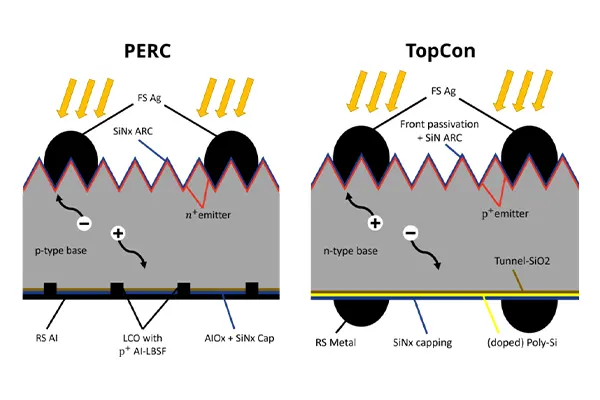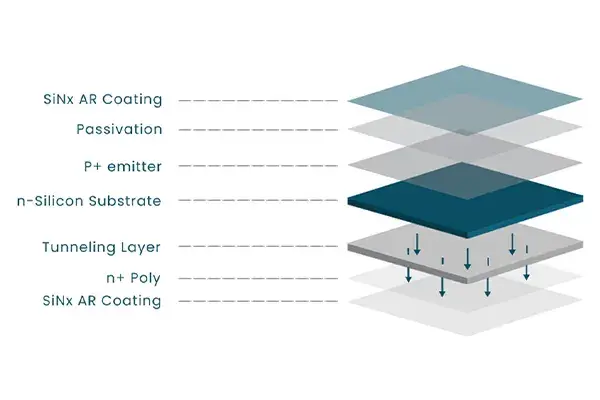Topcon Technology: The Next Big Thing in Solar
In the ever-evolving world of solar technology, innovation is the key to unlocking new possibilities and driving sustainable energy solutions. One name that has been making waves in the industry is "Topcon Technology." This cutting-edge innovation is on the brink of transforming the solar landscape, offering the potential to revolutionize how we capture the sun's energy.

What is Topcon Technology?
TOPCon technology falls under the category of N-type solar cells, which are crafted from silicon wafers. These silicon wafers undergo a doping process with specific chemicals to enhance their electricity production capabilities. The key distinction between N-type and P-type cells lies in the doping material employed. P-type cells are doped with boron, whereas N-type cells receive doping with phosphorus.
The use of phosphorus for doping offers several advantages over boron. One notable advantage is the resistance of phosphorus-doped cells to degradation caused by oxygen, which can be problematic for boron-doped cells. Additionally, phosphorus doping introduces free electrons into the silicon wafer, ultimately leading to improved efficiency.
Within the realm of N-type cells, various subcategories exist, including PERT, Topcon, HJT, and IBC. Among these, TOPCon (Tunnel Oxide Passivated Contact) cells take center stage as the primary representative, showcasing the cutting-edge potential of N-type technology in the solar industry.
In the production of TOPCon cells, layers of tunnel oxide and polysilicon are applied to the rear side of the cell. This addition reinforces the cell's capacity to manage elevated voltages, resulting in a substantial boost in power generation capabilities.

How Does Topcon Technology Work?
Sunlight penetrates the solar cell primarily from the top side (and, in the case of bifacial cells, also from the bottom side) and is absorbed within the silicon material.
The absorption of sunlight initiates the creation of electron-hole pairs. Specifically, the electrons within the valence band absorb the energy from the light, causing them to transition to a higher energy state known as the conduction band. In this state, electrons are free to move from one atom to another, not bound to any single atom. Concurrently, holes, essentially vacancies left behind in the valence band when electrons jump to the conduction band, are generated. These holes can be thought of as positive charge carriers, but they move within the valence band in the opposite direction to electrons.
At the junction where the P-type and N-type regions meet, an electric field exists. This electric field compels the photo-generated electrons to flow toward the N-type region and drives the corresponding holes into the P-type region. This separation of electrons from holes prevents them from recombining, which would otherwise result in a loss of generated light energy.
These photo-generated electrons, after crossing the P-N junction region, progress toward the underside of the N-type layer, ultimately reaching the rear contact.
Inside the bulk of the N-type layer, additional electron-hole pairs are also generated. If these holes accumulate near the rear contacts, they can lead to recombination, as the Metal-Silicon Contact region acts as a potent recombination center, causing a loss of photo-generated electrons.
Enter the concept of Tunnel Oxide Passivated Contact (TOPCON). A remarkably thin layer of SiO2 tunnel oxide, typically just 1-2 nanometers thick, functions as a selective gate, permitting only electrons to pass through to the rear side while blocking the movement of holes. Furthermore, the n+ polysilicon layer creates an electric field that attracts electrons while repelling holes. This dual mechanism ensures that a significant number of electrons reach the silver contacts on the bottom side, where they are collected by interconnect ribbons and directed into the external load circuit.

Key Benefits of Topcon Technology:
Manufacturing Process:
The production of TOPCon modules shares common machinery with P-type modules, eliminating the need for significant capital investments by manufacturers when transitioning to TOPCon cells.
Higher Efficiency:
TOPCon cells outperform P-type cells in converting sunlight, resulting in superior cell and module efficiency. TOPCon cells can achieve efficiency levels of up to 28%, surpassing the maximum efficiency of PERC cells, which typically hovers around 24%.
Lower Degradation:
Compared to PERC panels, TOPCon modules exhibit lower power degradation during their first year of use and over the course of 30 years of PV panel usage. This durability and sustained performance make TOPCon modules an attractive choice for long-term solar installations.
Lower Temperature Coefficient:
The temperature coefficient measures the percentage of power output reduction per degree of temperature increase in a solar panel. It significantly affects the power generation of PV modules in hot climates. TOPCon cells exhibit greater resistance to high temperatures, resulting in higher efficiency for TOPCon modules in hot environmental conditions compared to PERC modules.
Bifaciality Rate:
TOPCon cells demonstrate a more substantial increase in power generation for bifacial modules than PERC cells. This attribute holds increasing importance as bifacial solar modules gain popularity in the market, enhancing their overall appeal.
Low-Light Performance:
TOPCon modules exhibit superior efficiency in low-light conditions, extending the period of electricity generation during the day. This improved performance ensures better overall installation performance over time, especially in areas with varying light conditions or during cloudy days.

The Future of Solar Energy
As the world transitions towards clean and renewable energy sources, Topcon Technology stands out as a game-changer in the solar industry. Its ability to harness more energy from the sun with precision and efficiency is driving the next wave of innovation in sustainable power generation.
Incorporating Topcon Technology into solar installations is a step toward a more sustainable and energy-efficient future. With its impressive benefits, it's no wonder that Topcon is gaining traction as the next big thing in solar technology.
Topcon Technology is a revolutionary approach to solar energy generation. Its ability to maximize energy output while minimizing environmental impact positions it as a formidable player in the quest for a greener, more sustainable world. As the solar industry continues to evolve, Topcon Technology is undoubtedly a significant milestone on the path to a brighter future.